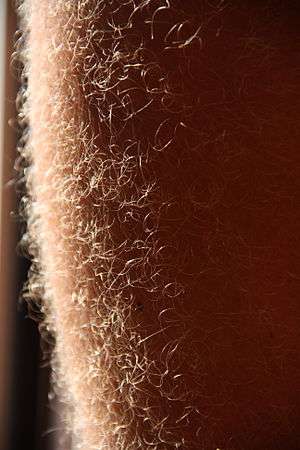Leg hair
| Leg hair | |
|---|---|
 Hair on the human leg | |
| Anatomical terminology |
Leg hair is hair that grows on the legs of humans, generally appearing after the onset of puberty. For hygienic, aesthetics reasons and for some sports, people shave, wax, or use hair removal creams to remove the hair from their legs: see leg shaving.
The current Guinness World Record for world's longest leg hair belongs to Jason Allen of Tucson, Arizona at 8.84 inches (22.46 cm).[1]
The Science Behind Leg Hair
The real action of leg hair takes place below the skin or the epidermis. The cells that are in the hair follicles divide and multiply. When the space fills up in the follicle it pushed older cells out and that is what becomes the leg hair. After the older cells become hard and leave the follicle, they form a hair shaft. The hair shaft is mostly made up of dead tissue and a protein that is known as keratin.
It is said that hair growth occurs during the "growing" phase of the follicle, and then retained as dead club hair during the "resting" phase. The old club hair might be lost within the following "growing" phase.
The Difference Between Men and Women
Men are seen to be much hairier than women, even though men and women are much less hairy than they once were, and evolution has changed that. Two different classes of hair are present within our bodies; classes include the coarse and pigmented hair, the pubic region and the thin layer of hair that covers the remaining parts of our bodies. It is when one analyzes the former type of hair, that is found when men and women differ the most. The differences between male and female hair is the color and the coarseness. What is to blame for the more abundance of hair on a man as opposed to a woman, is the higher level of the hormone testosterone in males that most females have a lower level of.
Protein Involved In Hair Growth
Fibroblast growth factor 5 (FGF5) is a secreted signaling protein. The expression of this protein is detected in hair follicles from the mice that scientists have experimented on. The hair follicles are localized to the outer root sheath during one of the phases of the hair growth cycle. Such experiments conclude that the protein FGF5 functions as an inhibitor when pertaining to hair elongation.
Seasonal changes are also known to affect hair growth. For instance, one experiment had concluded that the rate of hair growth for men and their beards was lowest in January and February and increased from March to July.
See also
References
- ↑ "Longest Leg Hair". Guinness World Records. Archived from the original on 25 May 2015.
Further reading
- Conger, Cristen. “Why Do Humans Have Body Hair?” HowStuffWorks, HowStuffWorks, 5 Nov. 2008, health.howstuffworks.com/human-body/parts/human-body-hair.htm.
- (Hair Growth: EMedicine Otolaryngology and Facial Plastic Surgery)
- Hébert, Jean M; Rosenquist, Thomas; Götz, Jürgen; Martin, Gail R (1994). "FGF5 as a regulator of the hair growth cycle: Evidence from targeted and spontaneous mutations". Cell. 78 (6): 1017–25. doi:10.1016/0092-8674(94)90276-3. PMID 7923352.
- Kageyama, Tatsuto; Yoshimura, Chisa; Myasnikova, Dina; Kataoka, Ken; Nittami, Tadashi; Maruo, Shoji; Fukuda, Junji (2018). "Spontaneous hair follicle germ (HFG) formation in vitro, enabling the large-scale production of HFGs for regenerative medicine". Biomaterials. 154: 291–300. doi:10.1016/j.biomaterials.2017.10.056. PMID 29156398.
- Chase, Herman B (1954). "Growth of the Hair". Physiological Reviews. 34 (1): 113–26. doi:10.1152/physrev.1954.34.1.113. PMID 13120379.
- Martinez, Carla. “Why Are Men Hairier than Women?” Metode, metode.org/metodes-whys-and-wherefores/why-are-men-hairier-than-women.html.
- “Beards, Baldness and Body Hair - Why Men Are Hairy.” Not-For-Profit Health Insurance, www.cbhs.com.au/health-well-being-blog/blog-article/2017/05/31/why-men-are-hairy